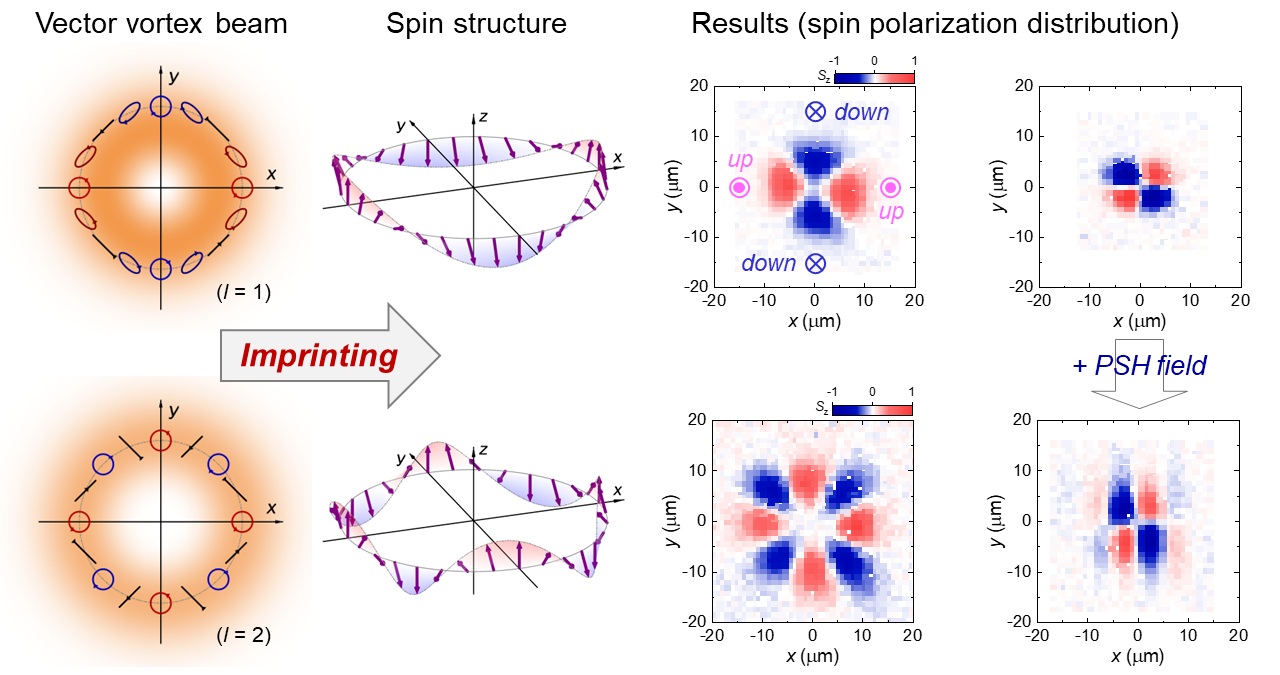Spin, a quantum property of particles, can be controlled using light waves to store information. This is conventionally achieved using a uniformly polarized light beam. Recently, researchers from Japan successfully generated a structured light beam with spatially variant polarization and transferred its structure to electron spins confined within a semiconductor solid. Additionally, they simultaneously generated two spin waves with inverted phases using this beam. Their results have important implications in optical communications and information storage.
 Researchers from Japan have utilized a vector optical vortex (left), a structured light with spatially variant polarization, for generating spatially structured spin states in a semiconductor quantum well (left). This is achieved by imprinting the vortex beam's structure on to the electron spins. Moreover, the combination of the excited spin texture and PSH fields leads to two helical spin waves with opposite phases. Image Credit: Jun Ishihara from TUS, Japan
Researchers from Japan have utilized a vector optical vortex (left), a structured light with spatially variant polarization, for generating spatially structured spin states in a semiconductor quantum well (left). This is achieved by imprinting the vortex beam's structure on to the electron spins. Moreover, the combination of the excited spin texture and PSH fields leads to two helical spin waves with opposite phases. Image Credit: Jun Ishihara from TUS, Japan
Light is composed of electric and magnetic fields that oscillate perpendicular to each other. When these oscillations are restricted, say, along a plane, it results in polarized light. Polarized light is of great importance in optical communications and can similarly revolutionize how information is stored.
Current electronic devices store information in the form of electronic charge. However, spin-a uniquely quantum property of electrons-offers an alternative. The spin can be controlled using polarized light to store information. A polarized light beam interacts with electron spins within a semiconductor to generate spin-polarized electrons, i.e., spins aligned along a specific direction. So far, only uniformly polarized light, i.e., light with a spatially uniform polarization, has been exploited to control electron spins. If, however, the polarization has an additional spatial structure (variation), it can produce spatially structured electron spins, opening up new ways to store information.
To this end, a group of researchers, led by Junior Associate Professor Jun Ishihara from and including Graduate Student Takachika Mori, Graduate Student (at the time of the research) Takuya Suzuki, and Professor Kensuke Miyajima from Tokyo University of Science (TUS), Japan, has now devised a method for generating such spatially structured electron spins using a structured light with spatially varying polarization profile. The study, published in the journal Physical Review Letters, was done in collaboration with research groups from Chiba University, Tohoku University, and Tsukuba University in Japan.
"In this work, we generated a doughnut-shaped structured light-a vector optical vortex beam with an orbital angular momentum (OAM)-from a basic Gaussian beam using vortex half-wave plate and quarter-wave plate devices. We then used this beam to excite the electron spins confined within a gallium arsenide/aluminum gallium arsenide semiconductor quantum well. These spins, in turn, formed a helical spatial structure in a circle," explains Dr. Ishihara.
Interestingly, while the beam with an OAM number equal to one produced a helix with two spin periods-spin up and spin down-around the circle, an OAM number of two resulted in a helix with four such alterations. These observations indicated that the spatial polarization structure of the optical vortex, determined by the OAM, was transferred to the electron spins inside the semiconductor. In addition, increasing the OAM number was suggested to enable higher information storage capacity, characterized by higher spin repetition rate around the circle.
Moreover, the researchers utilized the effective magnetic field of the spin-orbit interaction acting on electron spins in the quantum well to simultaneously generate two spin waves with opposite phases in the vertical direction using a single beam. This suggested that various spin states with spatial structures could be produced by exploiting the effective magnetic fields (a characteristic of solids) alongside structured light beams.
With such exciting results, the researchers discuss the future prospects of their work. "The conversion of the spatial polarization structure of light into a spatial structure of spin along with the generation of new spin spatial structures in combination with effective magnetic fields in solids are expected to lead to elemental technologies for higher-order quantum media conversion and information capacity enhancement using spin textures," says Dr. Ishihara.
It may not be long before such spin-based information storage devices become a reality!
Source: https://www.tus.ac.jp/en/